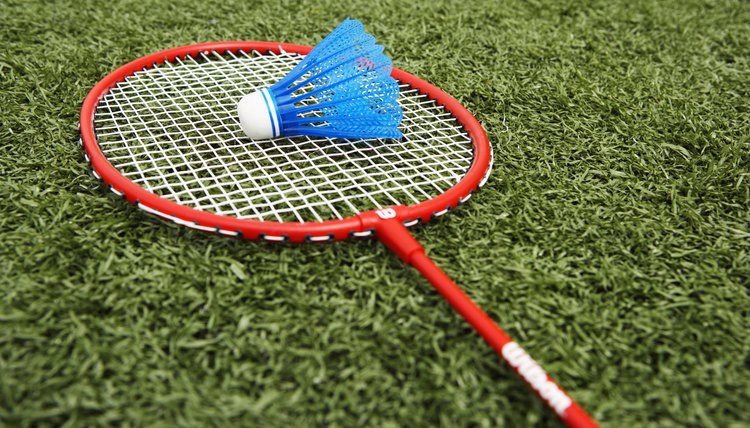List of Badminton Equipment

In badminton, players use rackets to hit a shuttlecock back and forth over a net. Badminton equipment must meet certain rules and specifications. The Badminton World Federation’s Laws of Badminton provide a standard for equipment in competitive badminton.
Shuttles
Players should have several shuttles, also known as “birdies” or “shuttlecocks,” to use in a match. You can use natural, feathered shuttles or synthetic, non-feathered shuttles in badminton. According to the Badminton World Federation’s Laws of Badminton, feathered shuttles should have 16 feathers fixed to a cork base. The feathers should measure between 2 ½ and 2 ¾ inches long. The feathers’ tips should form a circle with a diameter measuring between 2 ¼ and 2 2/3 inches. Synthetic shuttles should simulate feathers with synthetic materials. Both feathered and synthetic shuttles should have a base that measures about 1 inch in diameter. The shuttle should weigh about .16 to .19 oz. Players should test the shuttles for speed and flight before each match.
Racket
Badminton rackets consist of stringed hitting surface attached to a thin shaft and a handle. The racket must have a flat face, with a uniform pattern of overlapping strings. According to the Badminton World Federation’s Laws of Badminton, the racket’s stringed area should not exceed 11 inches in length or 8 2/3 inches in width. The racket’s overall length, including the handle, shaft, and face, may not exceed 26 ¾ inches in length. The racket must not exceed 9 inches in width at its widest point. Early badminton racket manufacturers produced only wooden rackets, but modern manufacturers produce rackets with frames made out of aluminum alloy, titanium, steel, and composite materials.
Net
The net plays an important role in badminton matches. The Badminton World Federation’s Laws of Badminton provide specific standards for net height, width, and construction. An official badminton net must measure 5 feet high in the center, and 5 feet, 1 inch at the sides. The net attaches to vertical posts on either side of the court. The net should measure 30 inches from bottom to top, and must consist of a uniform, dark-colored mesh. The net should have a white tape running along the top to make the net’s full height visible to players and officials.
Writer Bio
Lisa Porter began writing professionally in 2009. She writes for various websites and has a Bachelor of Arts in English literature.
